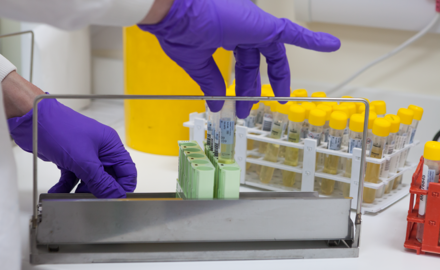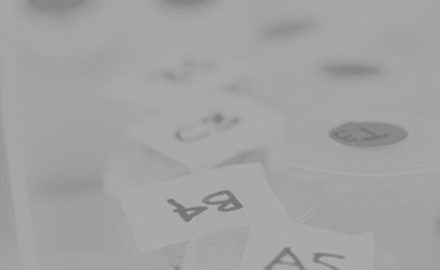Each year, the College runs an Art of Pathology competition, where people of all ages can submit paintings, drawings, sculptures, digital art, collages or any other media on a specific theme. This year’s theme was ‘The Science Behind the Cure’. Participants were invited to interpret this theme in their own unique and creative way, while exploring different aspects of pathology. The research and science involved in prevention, diagnosis and treatment of disease underpins pathology practice and we welcomed entries that convey this and the fascinating and essential work of pathologists and clinical scientists.
The competition is open annually to UK and international entrants of all ages. There are 3 categories for entries: under 11s, 11–17 and adults (over 18s). The judges of the Art of Pathology Competition are College Fellows working in a number of specialty areas.
Prizes
The Art of Pathology competition is kindly sponsored by Sonic Healthcare UK. £1,000 will be awarded to the winners of the over 18 and 11–17 categories. For the under 11s category, the winner will receive £500 and another £500 will be awarded to their school. There will also be 2 runners up prizes in each category. In the under-11 category, the runners up will receive £250, with an additional £250 awarded to their school. The runners up in the 11–17 and adult categories will receive £500.
The winning entries will be published on the RCPath website and featured in the College magazine, The Bulletin. The winning artworks will be exhibited in the College Members’ Room, with a reception sponsored by Sonic Healthcare UK. The artwork will also be used by Sonic Healthcare UK to support their recruitment campaigns and Sonic Healthcare UK may use images on their website and other promotional collateral. Scroll down to see the winning entries from 2019–2023.
Competition judges
Our 2024 judges were Dr Arthi Anand, Consultant Clinical Scientist in Histocompatibility and Immunogenetics, Professor Sarah Coupland, Consultant Histopathologist, University of Liverpool and Registrar of RCPath, Dr Noha El Sakka, Consultant of Microbiology and Virology, NHS Grampian and Vice President (Communications) of RCPath and Dr Stephen Morley, Consultant chemical pathologist, University Hospitals Leicester and Assistant Registrar of RCPath.
About our sponsor: Sonic Healthcare UK

The Art of Pathology competition’s sponsor, Sonic Healthcare UK, are leaders in consultant-led diagnostics, innovation, value, and long-term investment in healthcare provision. They have over 30 years’ experience in the UK pathology market and have been working in partnership with the NHS for over 20 years.
Sonic Healthcare UK has been at the forefront of COVID-19 testing for the UK since the disease first emerged. The team has developed new testing methods, worked closely with hospitals, helped others open their own labs, and by the end of September 2020 was processing more than 10,000 PCR tests a day.
Sonic Healthcare UK, which incorporates the TDL Group of laboratories and services, is part of the Sonic Healthcare group, one of the world’s largest clinical diagnostics groups with a demonstrated track record of medical excellence. Find out more at www.sonichealthcare.co.uk.
"Hippocrates said ‘Wherever the art of Medicine is loved, there is also a love of humanity’. In line with its company values of clinically led patient-centred pathology Sonic Healthcare UK is proud to sponsor the RCPath Art of Pathology competition. We believe this popular competition reflects both diagnostic science and an individual’s artistic vision of healthcare…whatever their age." – Dr Rachael Liebmann OBE, College Fellow and Group Medical Director of Sonic Healthcare UK
2024 winners
Over 18 Category
Winner: 'The Scientists We Thank' by Isabella Falltrick ( UK)

I wanted to explore how the role of the modern pathologist came to exist. A look at different specialties and historical figures that have contributed to the science that pathology has been formed from. There’s no science without people, and there’s no cure without science.
Runner Up: 'The Anatomy of Pain' by Dominika Kolenda (UK)
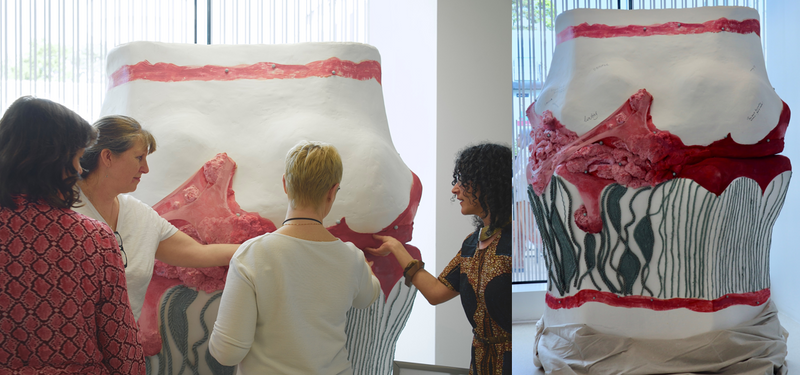
The 2.5-meter-tall, 200 kg sculpture is built on a sturdy wooden structure, wrapped in chicken wire, and layered with plaster. Detailed with latex, ropes, plasticine, clay, tights, and sprays, the sculpture's lifelike texture is enhanced using acrylic paints, effectively capturing the inner world of the diseased knee joint's intricate and unsettling appearance.
The sculpture of an enlarged, diseased knee joint suffering from osteoarthritis embodies the theme "The Science Behind the Cure" by making the invisible pain visible. Engaging patients and researchers in workshops to write their thoughts on the sculpture bridges the gap between complex research and patient understanding, reducing alienation and fostering empowerment. The sculpture was made in cooperation with the Kennedy Institute of Rheumatology, specifically histopathology lab: Ida Parisi, Rhiannon Cook and Oyindamola Ajisegiri.
Runner Up: 'The Cellular Level' by Zaynab Hussain (UK)
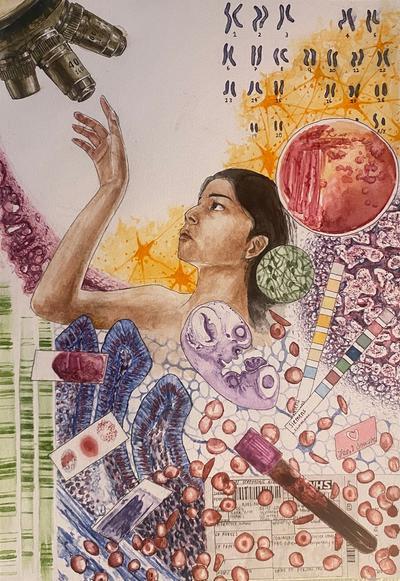
My watercolour painting aims to capture the essence of pathology as a bridge between diagnosis and treatment, highlighting the scientific processes that lead to a deeper understanding of disease. It is heavily inspired by investigations at the cellular level, celebrating the unseen heroes of medicine working behind the scenes.
Commended: 'Revolutionizing Medicine: Transforming Healthcare Through the Synergy of Pathology and Artificial Intelligence' by Aditi Rohan Sawant (UK)
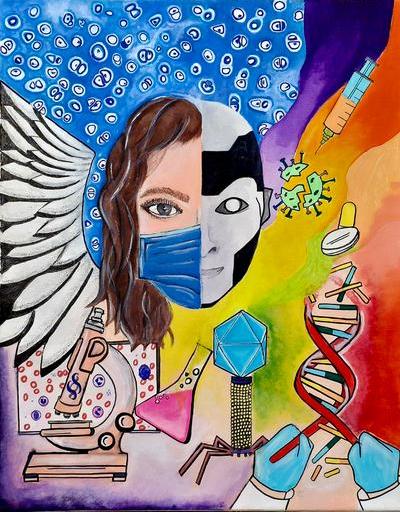
This is a canvas portrait built up over months with help of oil paints, crayons and colour pens. The brushes (1 - 6 no) were used for fine highlights and strokes.
This canvas portrait vividly represents the blend of artificial intelligence and pathology in modern medicine. A split face illustrates their integration, juxtaposing conventional and digital pathology. Hands holding DNA strands highlight genetic advancements, guided by the Royal College of Pathologists. The microscope’s emblem symbolizes the College's pivotal role in shaping the future of pathology.
Overall, the artwork narrates science behind cure through the use of bright oil paint conveying a sense of hope and healing.
Commended: 'B.O.B (Blocks of Biochemistry)' by Karen Mitchell (UK)
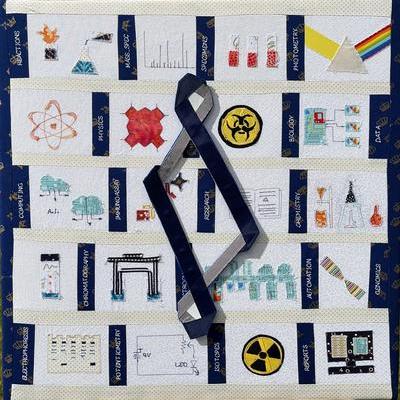
The collage is made of individual applique blocks using different hand and machine sewn elements, quilted together. Each block has a machine-embroidered name associated with it and layered in a brick formation. The logo for the College is mounted using chicago screws to provide a 3-dimentional element raised above the main picture. The collage is mounted on a canvas frame 60 x 60 cm.
I was inspired to show biochemical techniques and processes in a visual form using textile art. Biochemistry and laboratory medicine analysis is largely automated but I was keen to represent different aspects, techniques and reports to show the diversity, all hidden behind the logo of the Royal College of Pathologists.
Commended: 'In Vitro Fertilization, the aspiration of love' by Dr Samina Khan Bhatty (Pakistan)
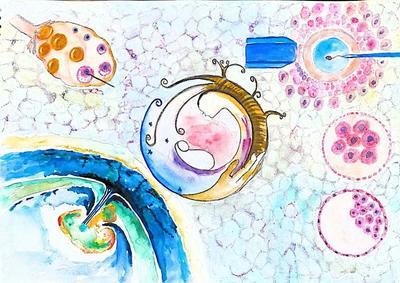
Reproductive Science,the branch of Pathology, is behind the cure of infertility. It has relieved the pain of infertility. The egg is harvested from ovary and fertilization is done in vitro, the embryo is placed inside the uterus and journey of love begins. This is the procedure that brings forth the miracle of life. The In vitro fertilization is the cure that consultant clinical scientists have sorted out .This seed leads to a beautiful tree, the roots of which harvest the genuine bond between a mother and a child.
Commended: 'A Good Response' by Moses Ojo (Nigeria)
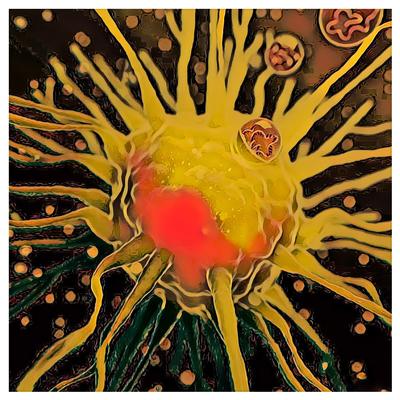
An mRNA (messenger ribonucleic acid) vaccine (pink) entering an antigen presenting cell/dendritic cell (yellow), producing antigen proteins and peptides.
Once the mRNA vaccine enters the dendritic cell, it instructs the cell's machinery to produce the specific antigen protein.
- The antigen protein is then broken down into smaller pieces called peptides.
- These peptides are displayed on the surface of the dendritic cell, bound to molecules called Major Histocompatibility Complex (MHC) molecules.
Commended: 'Decoding disease - Pathology holds the key to cure' by Dr. Ragavi V (India)
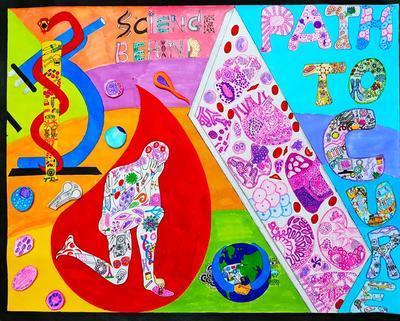
Medium- chart, Materials used- crayons, brush pens, water colour, colour pens, double tape for cell stickers, all the drawings were hand made.
This art is in 6 parts
1.Rod of Ascelpius depicting various pathology specialities along with microscope
2. Ill human within blood drop depicting various causes of disease diagnosed by blood test
3. Throughout the world pathologists were connected, share knowledge and opinions through technological advancements
4. A microscopic slide depicting individual organ pathology
5. "Science behind " with instruments, Path to cure with pathology related doodles from morphological to advanced technological pathology.
6. Background with pastel colours highlighted by classical cells for the morphological diagnosis
Commended: 'Sometimes the answers we seek have been there all along' by Réiltín Tynan (Australia)

I used tea to stain the background, with watercolour and pencils used to create the various cells. Tea staining has been used since ancient times, and reminded me of old books and maps. Sea salt on wet paint added texture with chemical reactions creating sections that appeared similar to granules in inflammatory cells. Gold leaf was added to the breaking DNA strands.
Modern microscopes are very similar to the first designed; still operating with an eyepiece, light source, means of focusing and lens magnification. In certain cases we are looking at the same cells they did in ancient times with better understanding. Understanding double-stranded DNA breaks may prove invaluable in the future.
11–17 Category
Winner: 'Facing Solitude' by Maryam Malik (UK)
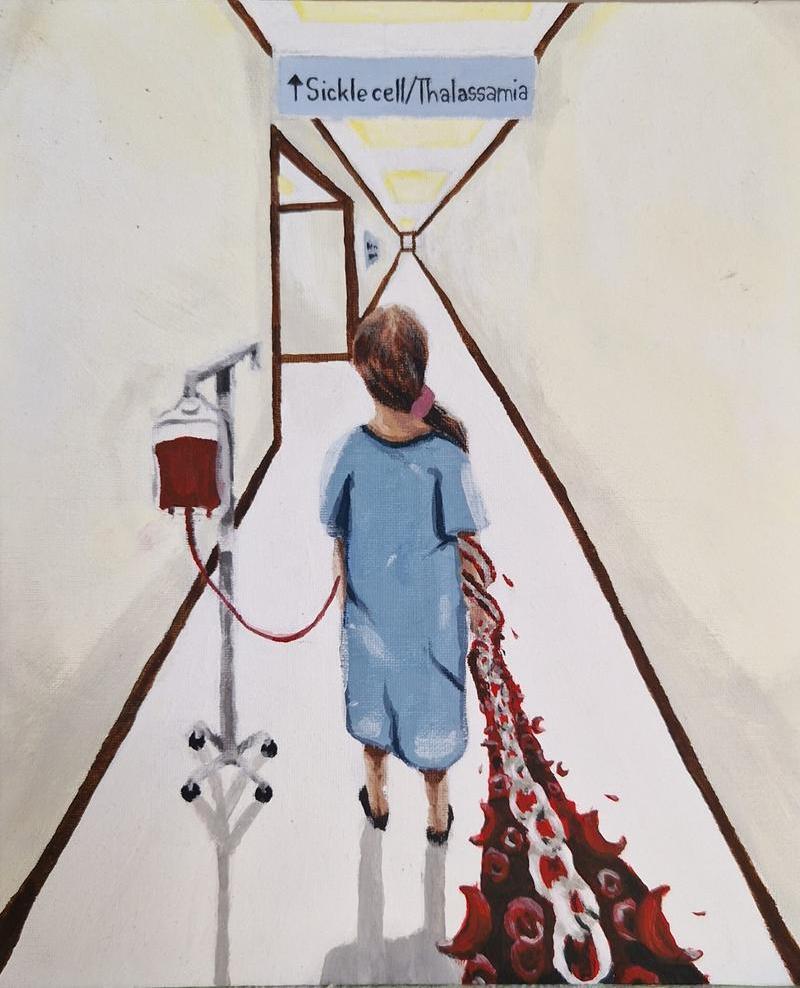
I mainly used an acrylic medium. The Hospital directions are in a black ink pen.
My entry represents the state of mind of a patient with sickle cell anaemia. The Iv drip and hospital corridor depict the pathway to one of the many treatments, but I made sure to keep mental health as a key component when researching diseases through things such as bodies/body tissues.
Runner Up: 'The confused teenager! Science is an answer to both' by Hiba Zainab (UK)
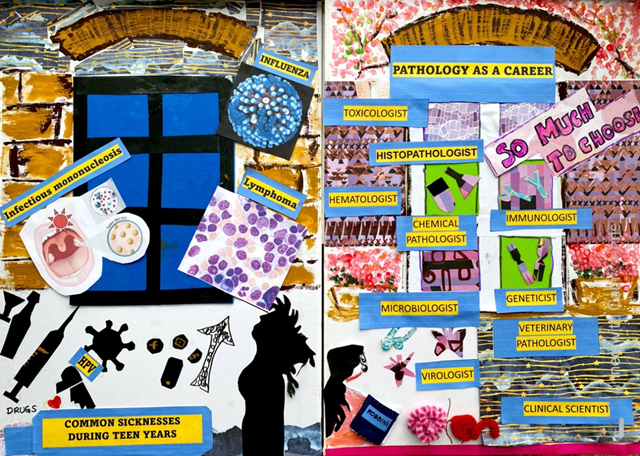
Two pressing concerns for teenagers are health risks and career choices. Pathology offers solutions for both. The first half of the picture highlights common illnesses in this age group while the other half shows the possible avenues if one chooses Pathology as a career option
Runner Up: 'The Pathologist Behind the Cure' by Zarwa Yasin Chaudhry (Pakistan)
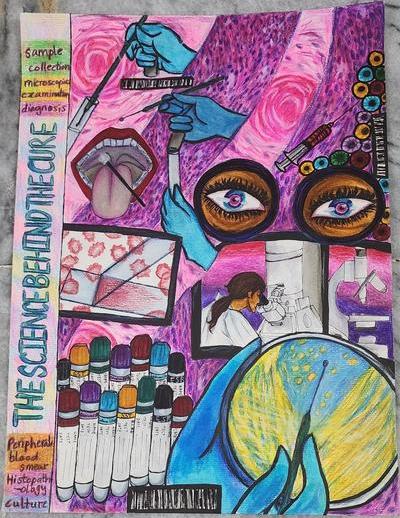
The drawing was made using colour pencils, alcohol based markers and water based markers. The histopathology of Kaposi Sarcoma and Sqaumous Cell Carcinoma, the echinocytes and agar CLED were coloured with colour pencils.
Pathologists investigate diseases. Methods of investigating disease are listed in the artwork. Barcodes shown are used by patholgists to make lab work more efficient. Special emphasis is placed on the pathologist's expert gaze, looking through the electron/light microscope and their expert handling of equipment and apparatus. Thus, the pathologist's observations and work is the science behind the cure.
Commended: 'The Eye of the Pathologist' by Amy Elghobashy (UK)
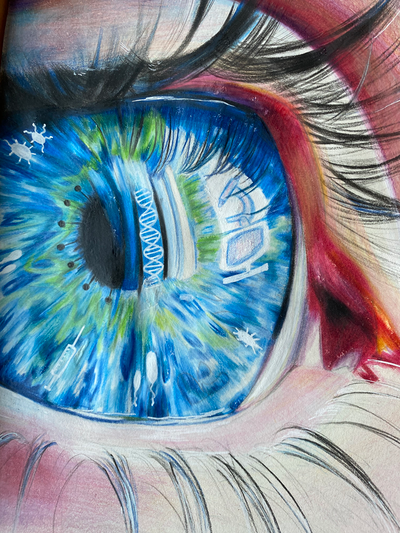
Coloured pencil and acrylic marker drawing on sketchbook paper, using the burnishing technique.
My piece is inspired by the multifaceted nature of pathology; the pathologist's eye contains several structures related to the overarching specialty, such as a DNA strand, a microscope and digital monitor, a syringe and various pathogens, including the Covid virus, the iris of the eye.
Commended: 'The 'Cure' to Smallpox' by Astrid King (UK)
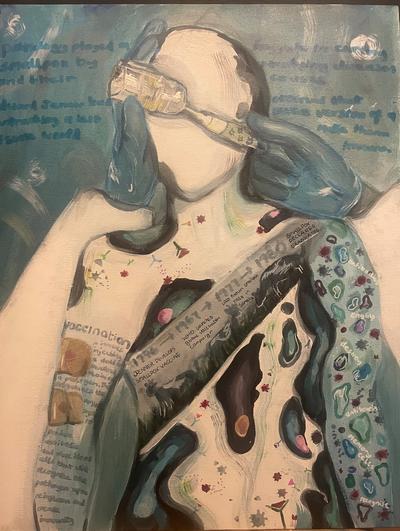
Smallpox is the first disease in human history to ever have been eradicated—because of global vaccination. This was the first and leading point on my GSCE Biology topic of Infection and Response. What I learned was that Edward Jenner’s scientific observations in 1796 proved correctly on a microscopic scale, looking at how white blood cells interacted with pathogens: being the premise of pathology.
Commended: 'Under the Lens' by Anjali Sathish (UK)
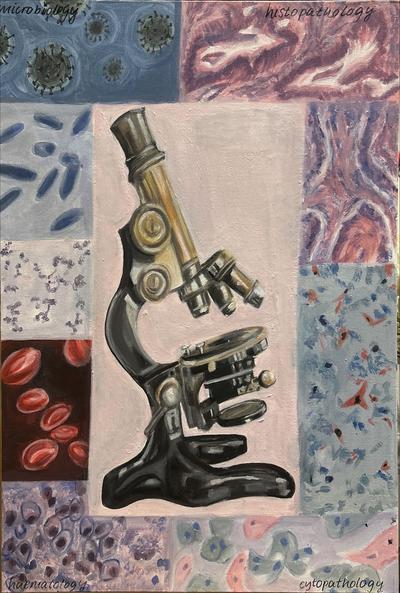
I have used acrylic paints on a canvas board sized 40 x 60 cm.
Central to the painting is an old uniocular light microscope surrounded by a variety of organisms and cells. The microscope’s design underlines the work of pathologists. In each corner I’ve focused on a different branch of pathology. This painting conveys that the morphology of the cells determines the diagnosis, treatment and prognosis of a disease.
Under 11s Category
Winner: 'Eyes of Pathologist' by Ibrahim Asad Haroon (UK)
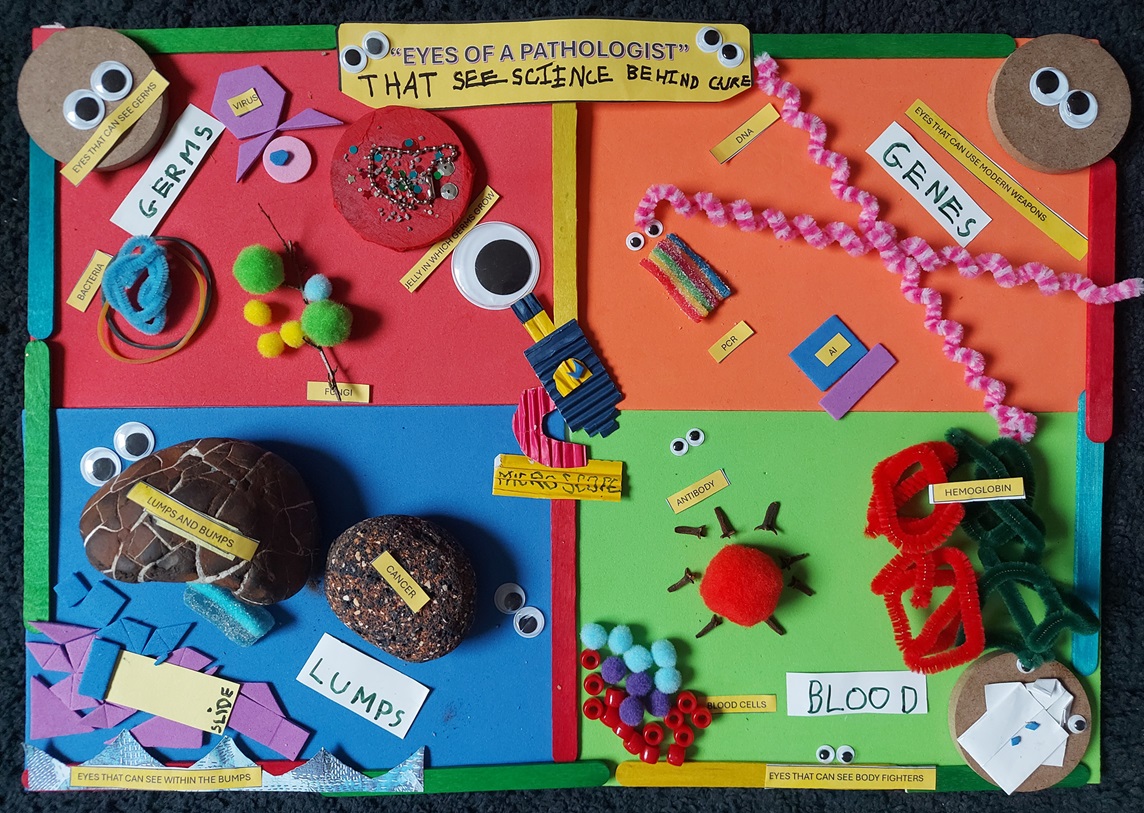
Runner Up: 'The Stages of life through a Pathologist’s lens' by Yusuf Asad Haroon (UK)
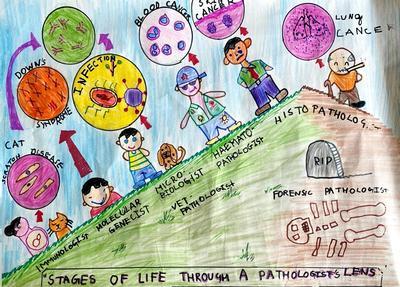
Runner Up: 'Key to the hidden world of medical science' by Advik Mohapatra (India)

My artwork and the title is inspired by the role of Pathologist who plays a pivotal role in medical research and their contributions extend beyond diagnosis and to develop treatments and cure to prevent diseases . Pathologist's tool, the microscope that enables us to explore the key to the hidden world that exist beyond the naked eye and helps to find the causes, mechanisms and cure of the diseases.
Commened: 'A Rainbow Connection' by Danielle Lo (Malaysia)
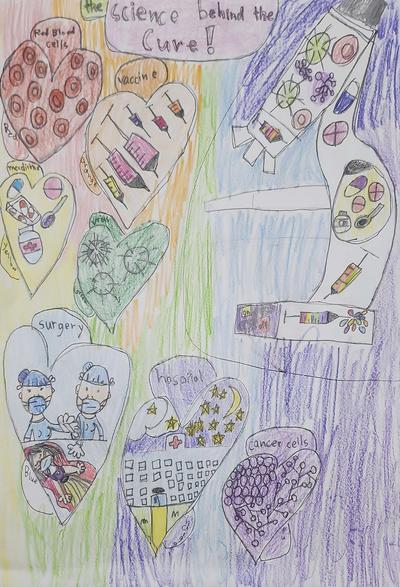
Doctors help patients because they love. Surgeons and pathologists work together to find ways to make patients better. The pathologist helps doctors give the right medicine. I used rainbow colors because rainbows represent the hope that patients have for a cure.
Doctors help patients because they love. Surgeons and pathologists work together to find ways to make patients better. The pathologist helps doctors give the right medicine. I used rainbow colors because rainbows represent the hope that patients have for a cure.
Please note, any personal all data collected in this competition will be kept only for the duration of the competition to notify winners, to send back art entries and to pay winners. All information will be kept in compliance with the College’s privacy policy.
Terms and conditions
Please read the Terms and Conditions document below for more information about the competition.
Further information
Inspiration ideas
Entrants were encouraged to consider the following questions to use as inspiration for their artwork.
-
What is pathology? This page provides an overview of pathology and includes a short video.
-
How do pathologists look after your health?
-
Did you know that there are 17 different specialties within pathology? You can explore one or more of these specialities when creating your artwork, or look at pathology as a whole. Visit our careers pages for more information.
Other resources
- A history of pathology in 50 objects
- Video: Discussing histopathology - past, present future
- Check out our previous Book Club events
- Listen to our Pathologists in Profile podcast
- Visit the Science Museum's Medicine page
- Viruses and Vaccines activities pack – explore the fascinating world of viruses, and understand more about the science behind COVID-19, immunity and vaccines.
- Our YouTube channel and Public Engagement videos
- Meet the Experts
Browse our site for ideas and to learn more about the science behind the cure.

